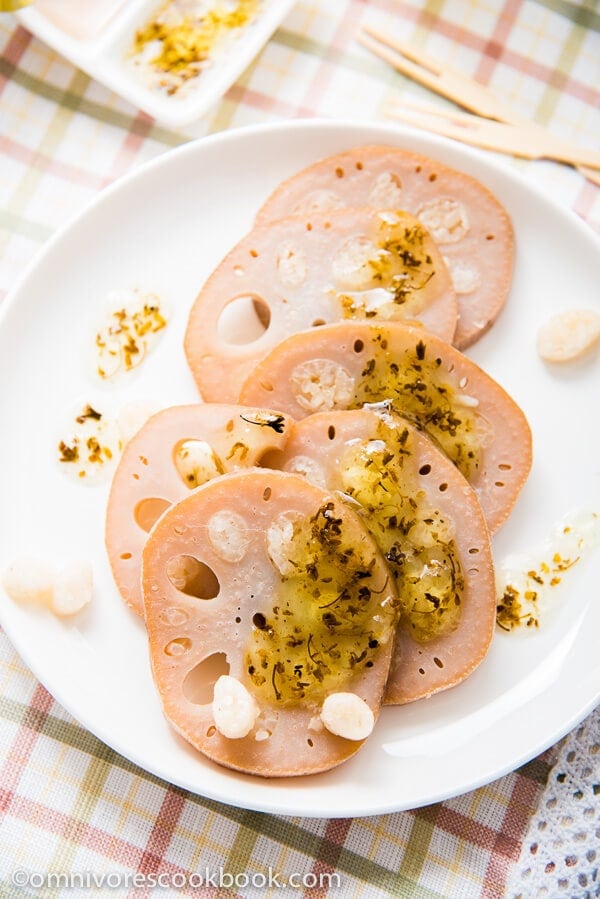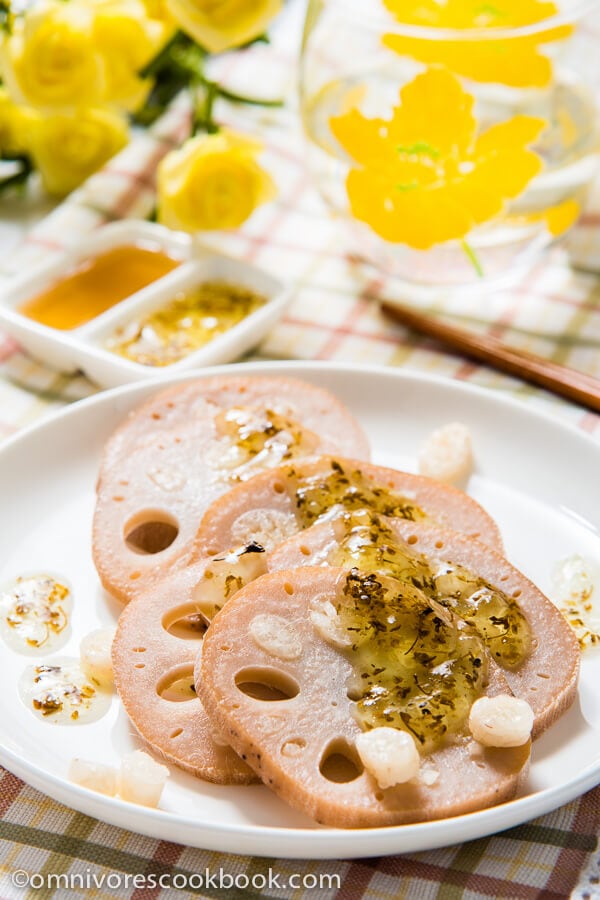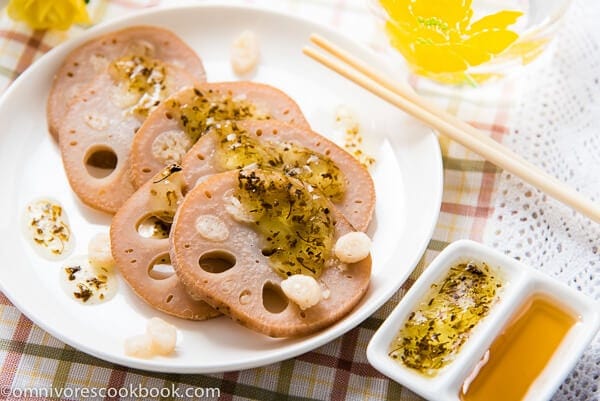
The sweet aroma of this dish brings flowers to mind. The root of the lotus plant is stuffed with sticky rice, slow cooked in a sweet broth until tender, sliced to reveal the floral pattern, and drizzled with flowery osmanthus syrup.
Honey lotus root with sticky rice is a classic and special appetizer from Southern China, and is particular to Jiangsu, a province adjacent to Shanghai. Lotus root is stuffed with sticky rice, boiled with sugar until tender, then served with a sweet and refreshing osmanthus syrup. Although the dish is sweet, and is referred to as a dessert sometimes, it is always served as an appetizer in local restaurants.
Lotus root is a popular ingredient in Chinese cooking and Chinese medicine due to its health benefits. Lotus root contains a moderate number of calories for a root vegetable. It’s high in dietary fiber and vitamins C and B and contains a good amount of important minerals. Fresh lotus root can be added to stews, salads, soups, and stir fried and braised dishes. It can be ground into powder to make drinks, or to processed to make lotus starch. It’s a very important part of Chinese cuisine, in the same way the potato is to American food culture.

In this dish, the lotus root will lose most of its crispiness and crunchy texture during simmering and become very tender. The glutinous rice tastes gooey, sweet, and infused with a nice aroma from the lotus root. The osmanthus syrup has a flowery fragrance, an amber color, and sweet taste. It adds a nice touch to the whole dish.
You might find that all the ingredients in this recipe look unfamiliar. The truth is, it’s really easy and fun to cook this dish, and you can find all of the ingredients in most Asian markets. It is definitely not a dish that you want to cook on a weekday, because the rice stuffing process requires some patience. This dish is easy to cook in large quantities in advance, to be served the following day. So for that reason I consider it a great party food, especially if you want to surprise your guests.
Take note, that although the rice has “glutinous” in its name, it’s actually gluten-free.

A Few Cooking Tips
- Soak glutinous rice for at least 3 hours, up to overnight, so it can be cooked through and create a better mouthfeel.
- Rock sugar can be replace by white sugar, if you don’t have rock sugar in your pantry.
- Stuff the root carefully and try to fill up all the tubes with glutinous rice. It’s time consuming work. I like to sit down and turn on my favorite show during this step. It’s a great way to relax!
- Leave some space at the end of the tubes when you stuff the glutinous rice, because the rice will expand during cooking.
- Osmanthus syrup can be replaced by honey if you cannot find osmanthus. Honey lacks the refreshingness of the syrup, but adds a special richness to the dish. I consider it just as nice as the syrup.
Behind the Scenes
Honey lotus root is one of my favorite appetizers and I always order it in local restaurants whenever I see it on the menu.
When I had just started this blog, it was one of the earliest dishes that I planned to share, but I didn’t hit the publish button until now. The photo was darn difficult to shoot and the dish looked horrible in the photo, no matter how good the dish tasted.
I almost gave up on this one when I had just finished the cooking and placed the lotus slices on the plate. The rice stuffing had a similar pale color to that of the lotus root. The whole dish was lacking in color, dimension, and texture in the photo. My instinct was that it was too ugly to put on the blog!
But somehow, I followed through and started styling. In the end, I tried to pop out some of the rice stuffing to show the hollow part of the lotus root. It revealed the shape of the lotus tube and worked out great! And the dish looked much better after I put extra syrup on top. Great lesson learned, there is no ugly food, and you’ll get where you want to go if you try really hard!

Chinese Cooking Made Easy
Are you new to this website? This free email series is a great place to start. I’ll walk you through a few of my most popular recipes and show you how and why they work. You’ll quickly start to cook better Chinese food in your own kitchen.

Honey Lotus Root with Sticky Rice (糯米藕)
Ingredients
- 150 grams (5 ounces) glutinous rice
- 2 teaspoons white sugar
- 1 400 grams fresh lotus root (*see footnote 1)
- 100 grams (3.5 ounces) rock sugar (or 1/2 cup white sugar)
- 2 tablespoons brown sugar
- 4 tablespoons osmanthus syrup (or honey)
Instructions
- Add glutinous rice into a small bowl and rinse it 2 to 3 times. Add water to cover rice with 1 centimeter (0.5 inch) excess. Let the rice soak at room temperature for 4 to 5 hours or in the fridge overnight (cover / wrap the bowl if placed in the fridge).
- Drain the rice. Add white sugar and mix well.
- Wash lotus root carefully. Peel the rind off and discard it. When you cut off the tough ends, be careful not to cut off so much that you reveal the tubes.
- Cut about 2 centimeters (1 inch) from one end of the lotus root. Save the small piece that you cut off to use as a lid.
- To stuff the lotus root with glutinous rice, add a spoonful of rice onto the cut end and use a chopstick to push the rice into the holes. Use a chopstick to squeeze the stuffed rice and compress it. Carefully fill up all the tubes, including the small ones. (It will take some time. I highly suggest you sit down and play your favorite TV show while doing this.)
- Place the small “lid” back to cover the cut end, in exactly the position it originally was (so the glutinous rice will expand into the holes of the “lid” during cooking). Use 6 to 8 toothpicks to seal the “lid”. You should push the toothpicks as far in as you can. The glutinous rice will expand during cooking and the “lid” will fall off or be pushed apart if not sealed carefully.
- Add lotus root to a small pot, with 2 cups of water to cover (*see footnote 2). Add rock sugar (or white granular sugar) and brown sugar. Bring to a boil over high heat. Stir during boiling to dissolve the sugar.
- Turn to low heat, cover, and boil for 1 hour. Keep the water boiling throughout. Flip the lotus root after 30 minutes and add more water to cover it, if necessary.
- Turn to lowest heat to simmer for another 20 minutes. Flip the lotus root 4 to 5 times during cooking.
- To serve after cooking, transfer the lotus root to a cutting board and allow it to cool. Cut into evenly thick slices when the root is cool enough to handle.
- To serve later, leave the lotus root in the pot until it cools off completely before slicing. If you plan to serve it the next day, place the lotus root in an airtight container and add the sugary water to cover. Store in fridge.
- Drizzle osmanthus syrup (or honey) on top of the cut lotus root. Serve warm or cold.
Notes
- Try to select short, fat, and straight segments of lotus root. It’s easier to stuff than a long segment.
- Try to select a small pot, one that can just fit in the lotus root. If you use a big pot and the 2 cups water cannot cover the lotus root, you should add more water and increase the amount of rock sugar and brown sugar accordingly.
- To double the recipe, only double glutinous rice, white sugar and lotus root at first. If 2 cups of water cannot cover the lotus root, you should add more water and increase the amount of rock sugar and brown sugar accordingly.
Nutrition

Did you make this recipe?
I’d love to hear how it turned out for you! Please take a moment to leave a 5-star rating ⭐️ and share your thoughts in the comments further down the page. It really helps others discover the recipe too.


Sabena
LOVE osmanthus and lotus roots but have never had sweet version of lotus root. I know thjs will taste amazing! Thank you for sharing such a unique recipe.
Vivian
Thanks for the recipe! I had some issues with the cap coming off, but the end result was still delicious. I chopped up some jujubes to stuff with the rice, and it added a nice additional touch of sweetness. And the chilled leftover sugar water served as a refreshing drink, so we got two dishes out of one!
kayla
Where can I get Osmanthus syrup? Do you make it yourself, if so, do you have a recipe? Thanks!
Maggie
Hi Kayla, you usually can find Osmanthus syrup in an Asian market. I’ve never thought about making it, but I’d love to look into the recipes.
If you cannot find it, you can use some honey or maple syrup as a replacement.
kayla
Thanks! I googled around for it first but the results were disappointing so I didn’t realize the local Asian store would have it. Glad to know they do, will try and find it next time I go.
Kayiu @ Saucy Spatula
Growing up, I’ve always had lotus roots in soups but never as an appetizer! This is so cool!
K / Pure & Complex
This meal is definitely perfect for this weather. This looks amazing.
Lokness @ The Missing Lokness
Your presentation and pictures are so incredible! I haven’t had lotus root for a while. They are unique tasting. If I can find some, I will sure try this.
Marissa | Pinch and Swirl
I’m so glad you posted this! I’ve been intrigued by lotus root, but honestly had no idea how to cook it. This looks delicious!
Nagi@RecipeTin Eats
LOVE lotus root, LOVE sticky rice, LOVE this recipe!! Pinning pinning pinning!!
Kathleen | HapaNom
This is such a lovely dish! I love lotus root, but I’ve never made it myself. The step-by-step photos are super helpful!
mira
Lotus root? I have to try it! Saw this recipe on Google+ yesterday and knew I’ll love it! Looks fancy and beautiful! Thanks for sharing Maggie!
Kelly
Yum! I love lotus root in soups and have never tried it in a dessert before. Sounds fabulous!
Sarah
Wow, this looks like a really fancy dish. I’ll have to try making this sometime when I have friends over!
Michelle @ Vitamin Sunshine
My husband loves lotus root– I’ve never cooked it for him! He bought it once and put it in a stirfry– I wasn’t a fan. But we had no idea what we were doing. I’ll have to try this! Do you have any other recipes with lotus?
Maggie
Hi Michelle, I’m so glad to know someone out there cares about lotus root! I understand your feelings about it, because I was not a big fan myself before! lol
I don’t have other lotus root recipe on the blog now, but the recipe I will share tomorrow has lotus root in it (spoiler alert: it’s a spicy one!). Also, I have a stir fried lotus root recipe coming soon, around next week. Don’t forget to come back and check on them 😉
Helen @ Scrummy Lane
This is really cool, Maggie! Never seen this before … but so glad you’ve introduced me to it. I’ll definitely be ordering it on my next trip to China!
Maggie
Hi Helen, I think this dish is still unknown by people outside of China, but it’s definitely worth trying! If you ever make a trip here, do let me know and I’ll pass a list of all the food you need to try out! 🙂